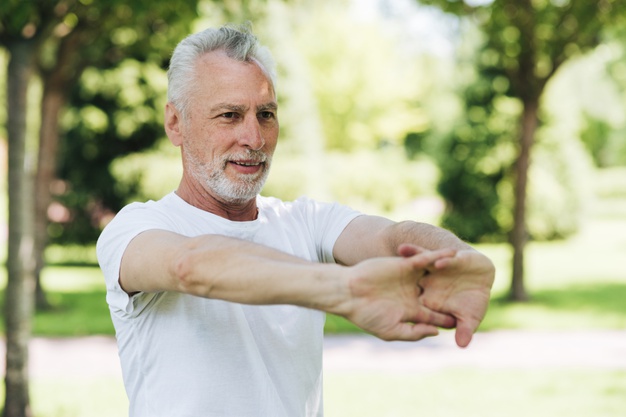

Parkinson Association of the Rockies (ParkinsonRockies) hosted a webinar on Practitioner Assisted Stretching for Parkinson’s Disease at the end of January. While there is much said about the importance of exercise in maintaining quality of life for those with PD by slowing disease progression, there is not much emphasis placed on the importance of stretching as a part of a good PD exercise routine. But stretching is of crucial importance. Here’s why.
If you immerse yourself in information about Parkinson’s Disease, like I do, you’ve seen the evidence that exercise slows the progression of Parkinson’s Disease. In short, in addition to the cardiovascular benefits, exercise can improve attention, thinking, and memory by increasing blood flow to the brain and encouraging neuroplasticity. Strength training maintains or improves balance, and according to studies, including this 2014 research review, “In combination with exercise, stretching reduces rigidity and improves joint and muscular capability in those with Parkinson’s.”
These two booklets that explain the importance of stretching and flexibility exercises, as well as online articles, podcasts & webinars, and expert-level resources are available on our web page, The Benefits of Exercise for PD.
Be Active & Beyond: A Guide to Exercise and Wellness for People with Parkinson’s Disease, by the American Parkinson Disease Association’s (APDA), is designed to help you develop an exercise program that works for you. Section III: Flexibility Exercise (pages 24-28) explains why stretching exercises are an important component of an exercise routine for people with PD. “Bradykinesia (slowness of movement) and rigidity (stiffness) can potentially put persons with PD at risk for losing muscle length or joint range of motion because the stiffness may contribute to moving in smaller ranges during motion. Stretching counters shortening of muscles and smaller range of motion. It also helps reduce discomfort from stiffness and muscle spasms.” This booklet highlights types of flexibility exercises someone with PD should do, the recommended amount of stretching to include in your exercise routine, tips for stretching safely and effectively, and describes four stretches to include in your exercise program.
Fitness Counts, by the Parkinson’s Foundation, also has a chapter on Flexibility Exercises (pages 21-15). “Stretching helps you fight the muscle rigidity that comes with PD. It also helps your muscles and joints stay flexible. People who are more flexible tend to have an easier time with everyday movements. While there are no standard stretching exercises for people with PD, the American College of Sports Medicine and the American Heart Association recommend guidelines for everyone.” This booklet summarizes those guidelines, suggests what parts of the body to focus on, offers tips for stretching properly, and describes 11 stretching exercises.
If you can’t stretch yourself or can’t stretch adequately, practitioner assisted stretching, also known as passive stretching, is available – although it may not be covered by insurance. It is the practice of having a trained, certified therapist stretch your body for you. If there is a trained, certified stretch therapist on staff, practitioner assisted stretching is offered by physical therapists, fitness centers, and massage therapists.
Stretch Zone is the fitness center featured in the ParkinsonRockies webinar. Stretch Zone’s franchise business model is to provide certified stretch therapists and practitioner assisted stretching as an exclusive service. There are no Stretch Zone franchises in Northern California. However, I did a Google search for “practitioner assisted stretching near me” and found a few fitness centers and massage therapists that offer practitioner assisted stretching in the Bay Area. None of them say they specialize in Parkinson’s disease, but I didn’t call any to ask. If you’re interested in practitioner assisted stretching, the best place to start is with your physical therapist. A physical therapist is by far the safest option and a limited number of visits may be covered by your insurance plan.
The ParkinsonRockies webinar on practitioner assisted stretching is one hour long. It includes COVID-19 safety guidelines you should ask about if you choose to do practitioner assisted stretching outside of a physical therapist office. It also includes testimony from Dave, who has young onset PD, and his wife, Nancy, along with video of Dave’s stretch workout at Stretch Zone (so you can get an idea of what to expect if you’re considering practitioner assisted stretching). The webinar was recorded and can be viewed on the ParkinsonRockies YouTube channel.
Happy stretching!
– Denise